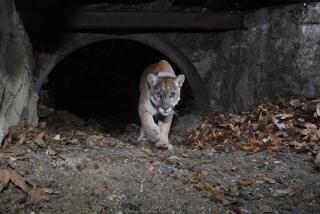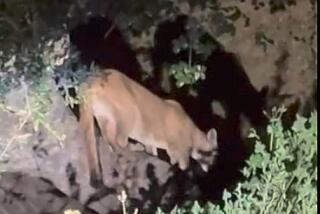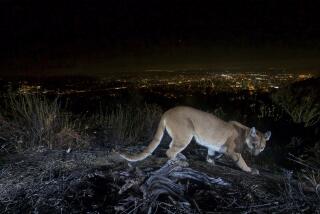Pet a Giraffe on Molokai
- Share via
KAUNAKAKAI, Hawaii — I never thought I’d go to Hawaii to climb trees and pet a giraffe on the island of Molokai.
But having braved the cliffs of Kalaupapa by mule the day before, I was primed for the promise of another Hawaiian adventure.
The road was rough, and dry earth spiraled in red dust clouds about the wheels of the van as we made our way toward Molokai Ranch Wildlife Park. Our sun-darkened driver and tour guide, Pilipo, deftly steered around large rocks and potholes in the road as if he knew where each one was.
Only 10 minutes before we had left the luxurious comfort and beauty of a resort with its miles of peaceful, virtually deserted beach, fringed with tall palm trees and grass as cool and inviting as the blue, clear water of the Pacific.
Quickly the landscape changed from the verdant tropical coastline to arid, desert-like plains covered with high, sun-bleached grasses, gnarled, almost leafless trees and tangled thickets of kiawe.
‘Much Like Africa’
“The terrain through here is much like Africa,” Pilipo said, making sweeping gestures at the wide expanse of open range on either side of the rutted, dirt road. “Especially Kenya and Tanzania,” he went on, telling us how the wildlife park was conceived in the late 1960s as an environmental project to gather species of animals from other parts of the world.
It was hoped that their grazing would also provide a means of controlling the rapid growth of grass and brush on the 60,000-acre Molokai Ranch, the second largest cattle ranch in Hawaii.
Giant eland, Barbary sheep, ostrich, giraffe and greater kudu are just a few of the wildlife imported from their native Africa to the island.
From India and southern Asia came sleek black buck antelope and white-spotted axis deer. Exotic rheas from South America were added to the growing menagerie. These large birds resemble the African ostrich, but are smaller and have three toes instead of two.
Other animals included ibex, a variety of wild goats, sable antelope--which are absolutely gorgeous in the sunlight--and oryx, a large African antelope with long, formidable straight horns that project backward.
Shipped to Oahu
After a three-month quarantine in Bakersfield, Calif., the animals were shipped from the mainland to Oahu for a second quarantine, then on to their new home where they adapted well in the Molokai wilderness.
The preserve, which takes up 800 acres of the ranch adjacent to the Kaluakoi resort development on the west side of the island, became a tourist attraction. Daily camera safaris are about an hour long, with frequent stops for picture-taking and the opportunity to walk among the animals.
We jostled along in the van, anticipating our first sighting of one of the nearly 500 animals that roam the mile-square park, when suddenly Pilipo made a right turn onto another unpaved, unmarked road. Then just as suddenly, he brought the van to a stop.
Our eager eyes followed him as he got out and walked slowly toward a high wire fence. We watched him unlock the padlock on a double gate that blocked the roadway and, in a burst of welcome, call out, “Hello . . . hello, there! Luna, are you there?”
From the underbrush beyond the gate rose a seven-foot ostrich, her black and white feathers rustling as she ran to meet us, her long neck stretching out with each loping stride until she reached Pilipo, then darted past him to stick her head inside the van window.
Assortment of Food
I dropped my camera and wasn’t sure if it was my voice or someone else’s that was squealing.
Small plastic buckets filled with a curious assortment of food were passed around to each of us. The 350-pound bird, with an insatiable appetite, thrust her beak first into one container then another, feasting on corn, calf-manna and alfalfa pellets.
When the park opened to tourists the tour guides were unfamiliar with the animals and their habits, so food was dropped off twice a day and the vans of visitors merely rode through, watching from the windows. With no human interaction, the animals were virtually unapproachable, with many of the species vicious and unpredictable.
In 1981 administration of the park was turned over to Pilipo, who took a personal interest in the animals and their welfare. He would drive through the reserve more than five times a day, letting the animals watch him from a distance with their suspicious eyes.
A self-taught gamekeeper, Pilipo began a study of zoology, browsing through library shelves, reading everything he could find about the wild, transplanted creatures. He learned how to approach them cautiously and talk to them. Eventually he attempted to feed a few of them by hand.
Trusting Relationship
A relationship of mutual trust developed. Some were bold enough to run up to the van when it stopped. Soon the animals became friendly and the boldest--the giraffes and the ostrich--would even pop their heads into the windows in search of food.
After Pilipo lured the ostrich back inside the compound with a tasty treat, we continued our trek. Luna chased along the fence after us in flying leaps as we drove through low rolling hills and golden yellow grassland to the first of two man-made watering holes.
Pheasant, wild turkey and families of quail darted in and out of brambly bushes. Two young giraffes ambled along at a leisurely pace, their orange-brown spindly legs half-hidden in the sun-scorched vegetation. Japanese spotted deer chased across the plain, stopping their game of tag momentarily to stare at us.
In this natural setting, more than 100 rare and endangered species of hoofed animals live and act much as they do in the wild, mating, raising their young and fighting over territory.
“They sometimes kill one another,” said Pilipo, recalling how vicious they were when he first worked with them. “You still have to watch the ones with horns.”
A Giant Eland
It was difficult to imagine any danger. By the time we reached the watering hole we had an entourage following us, led by a giant eland who was introduced to us as Makua Kane (grandpa in Hawaiian).
Through the van’s open window the eland gently rested his enormous head on Pilipo’s chest while he washed the old animal’s eyes and face with a washcloth. Like crossed fingers, Makua Kane’s twisted horns were locked, one over the other, from some battle long ago when he had instinctively fought to protect his own.
Moments later our emotions were overcome by the sound of hoofs thundering across the open field. We heard the Barbary sheep before we saw them. At first, all we could see was a dusty haze rising in the distance, then the long, curved horns above the dust.
When the coursing herd came into full view we were humbled by the display of raw nature. The magnificent sheep slowed as they neared the van and, with precision timing, came to a stop at the edge of the water hole.
Anxiously, we waited while Pilipo carried a huge sack of alfalfa cubes to a clearing beyond the water. The animals approached him quietly and began to eat the food he scattered on the ground. A lone sika--a small, graceful Japanese deer--drank from the watering hole, a serene contrast to the powerful African sheep.
Time for Photos
Giving the herd a few minutes to have their fill, we were invited out of the van for some close photography.
“Watch out for the horned animals,” Pilipo warned. He passed out bowls of pellets and grain for us to feed the rhea and deer, who were already nosing at our legs.
“What about the giraffes?” I asked.
“They feed from the trees,” said Pilipo, pointing to boxes placed high in the branches of nearby trees. He asked if I wanted to climb one of the trees with him to replenish the food boxes.
“I haven’t climbed a tree in 30 years,” I said, laughing, “but I was pretty good when I was a kid.”
After the first fork in the trunk, it all came back. With one eye focused on the next branch and the other on three giraffes striding toward us, I took it one branch at a time.
About 20 feet off the ground the realization hit me: I was at eye-level with the tallest of the giraffes, who reached the food box about the same time I did. He didn’t even hesitate.
Eating in Branches
His head stretched up into the branches and his mouth opened wide to allow the biggest tongue I’d ever seen lap up the manna in the box. The foot-long tongue darted in and out.
“Can I pet him?” I asked, in amazement to even myself.
“Sure,” said Pilipo, as if this kind of thing happens often. “This one’s name is Molkie.”
Molkie’s stately beauty was captivating. Reaching farther into the branches as he ate, the side of his head brushed against my shoulder. Just inches away, looking right at me, was the largest eye I’d ever seen.
I leaned in closer and gazed into the amber eye, marveling at its delicate fringe of buff-colored lashes that matched the eyelid exactly. “Hello, there, Molkie,” I whispered. “Here’s looking at you.”
Timidly, I stroked the top of his head between the two short, stubby horns. The spots on his coat, which look almost painted on from a distance, mottled together in short-haired patches of buff and tan, shading to light chocolate-brown. Petting Molkie was like rubbing one’s hand across a fine brush with bristles neither soft nor stiff. Except that the bristles were warm and moved gently with my touch.
A honk from the van brought me back to reality. I climbed down and waved aloha to my doe-eyed friend, with a vow to return to this enchanting slice of Africa in Polynesia.
-- -- --
Tours of Hawaii’s only exotic wildlife preserve leave Monday through Saturday from the Sheraton-Molokai Hotel. Camera safaris are scheduled at 8, 9:30 and 11:30 a.m., and 1:30, 3 and 4:30 p.m. Tour rates are $12 for adults and juniors, $6 for children under 12.
For reservations and information, call Rare Adventures, Sheraton-Molokai Hotel, (808) 552-2622, or write to Molokai Ranch Ltd., P.O. Box 8, Kaunakakai, Molokai, Hawaii 96748.
For group arrangements call (808) 553-5115.
More to Read
Sign up for The Wild
We’ll help you find the best places to hike, bike and run, as well as the perfect silent spots for meditation and yoga.
You may occasionally receive promotional content from the Los Angeles Times.






